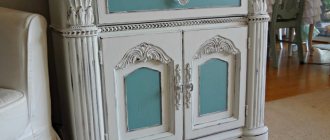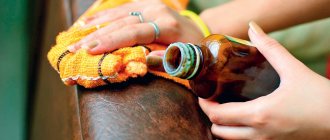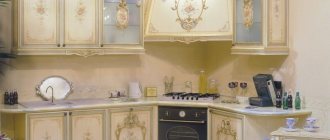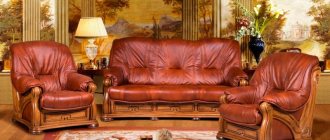Reasons for contamination of polished objects
Due to careless handling, stains appear on polished furniture.
As with any furniture, the main reason is dust settling on smooth tables, cabinets and bedside tables. But varnished surfaces not treated with antistatic agents have an increased ability to “attract” the smallest particles. Microcracks in the smooth layer also accumulate contaminants, which are difficult to remove. Therefore, the fight against dust on polished furniture is especially important.
Additional causes of pollution are:
- greasy fingerprints left after touching the polish;
- stains from any spilled liquid;
- stains from wet wiping of furniture that were not removed in time by additional polishing;
- stuck pieces of paraffin, wax or plasticine;
- traces from the impact of hot objects placed on the surface without gaskets.
In addition to dust, most pollution is created by one’s own hands as a result of negligence when handling furniture. You can avoid them by following simple rules. But we cannot rule out chance.
If stains do appear on polished furniture, you need to be able to remove them correctly without causing additional harm.
Safe cleaning tools
Polished furniture can only be wiped with a soft cloth or rag.
When processing polished furniture, it is easy not only to remove dirt, but also to damage the varnish layer. Therefore, it is unacceptable to use any harsh objects - scrapers, coarse bristles, abrasive sponges.
You need to use:
- cotton and flannel fabrics;
- suede cuts;
- cotton pads and tampons;
- pieces of soft leather;
- light brushes to sweep away dust.
To remove stuck-on dirt, you will need a table knife or a metal spatula.
It is advisable not to clean the surface of the furniture directly with sharp objects, but first slightly heat the metal over a fire or in boiling water. After this, the wax or paraffin will be easier to remove from the polish.
Safe chemicals for cleaning polished furniture
For lacquered furniture, you need to select products that clean and polish it at the same time.
The coating is sensitive to mechanical stress and is not resistant to many solvents and cleaning substances. Therefore, when choosing an industrial product, you must definitely look at the possibility of using it for polished surfaces.
It is unacceptable to clean lacquered furniture with any construction solvents - acetone, white spirit, gasoline. They will inevitably damage the polishing layer, making it cloudy.
Any cleaning requires subsequent treatment to restore and improve the smooth surface. Therefore, when purchasing products for the care of polished furniture, it is advisable to choose cleaners that also have polishing properties.
It is recommended to start using a new product by treating a small, inconspicuous area on the surface. This will avoid unpleasant consequences and damage.
Folk remedies for cleaning furniture
You can clean any polished furniture at home using numerous substances and liquids used in the household. For complex cases, there are recipes for safe but effective mixtures and solutions from several components.
Some of them are used only to remove dirt, but there are also compositions that allow you to polish the cleaned area, giving it its original shine.
For fresh stains
Fresh stains and fingerprints on polished furniture can be removed with powder.
To remove fingerprints and newly appeared traces of grease, use:
- Talcum powder or baby powder . Apply the powder to a cotton pad and wipe the stained area. On horizontal surfaces, it is better to simply sprinkle the dirt, wait 5-10 minutes and only then wipe. Remove any remaining talc with a dry cloth or soft brush.
- Raw potatoes . An old but proven remedy. It does not need to be poured or spread on anything. Rub half of the tuber onto the problem area. For best results, wait 3–15 minutes. After this, polish the rubbed area with a flannel cloth.
- Milk . This product is able to clean off light stains and at the same time restore the shine of the polishing layer. Use a soft cloth soaked in milk to walk over the stained area, and rub any remaining liquid with dry suede.
It is best to remove polish stains with a mild soap solution. Of course, you shouldn’t pour it on the surface of the furniture. Use a soft cloth lightly dampened with soap and water.
After wiping with any composition, be sure to immediately go over the cleaned area with polish or simply rub thoroughly with a flannel.
For strong and old stains
Place the old tea leaves in a fabric bag and wipe the polished surface with it.
If long-formed marks are noticed on polished furniture that spoil its appearance, it is better to use more complex means and compositions to remove them:
- Sauerkraut . A piece of soft leather is soaked in brine, and then any traces of dirt found are wiped off.
- Tea brewing . To clean polished surfaces, you don’t need to prepare it specially – you just need old remnants of used tea. They are wrung out and placed in a paper napkin or fabric bag. The resulting swab is used to wipe away dirt, followed by treatment with flannel.
- Beer . The drink is suitable for cleaning and polishing. It is preheated until it begins to boil. After waiting for complete cooling, apply to the contaminated surface. After drying, the resulting thin layer is removed with soft cloths and polished.
- Salt . With its help, you can reduce cloudiness caused by heating the varnish layer with hot utensils. Salt is poured into a bag, which is dipped in vegetable oil, and then the damaged areas are wiped.
- Vinegar . The heaviest stains are removed with a 9% solution. Moisten a cotton swab or pad and wipe the problem area. But you need to work quickly, otherwise prolonged exposure to vinegar can damage the polish. Immediately after cleaning is completed, wipe off all remaining liquid.
Cleaning stained furniture is half the battle. Any removal of dirt and greasy marks should be completed by treating the cleaned area with compounds to restore its shine.
How to clean polished furniture
Let's figure out how to clean a lacquered furniture set, depending on the characteristics of the dirt that has appeared on it. Most of the listed funds can be found in almost every home.
From fingerprints
Even if you touch a polished table or cabinet with perfectly clean hands, fingerprints will still remain. This is due to the fact that there are sebaceous ducts on the pads, which constantly synthesize sweat and fat secretions. To clean the set from stains, potato starch is best suited. It can be used in two ways at home:
- Sprinkle dry powder onto the affected area and leave to absorb greasy residue for five to seven minutes. Then clean the polished furniture with a soft cloth.
- Use a cut of a raw potato to go over the stained area. Then rub the varnish with a suede cloth.
From traces of hot dishes
It should be said that it is possible to properly clean the prints left from mugs of tea or coffee only if the dishes have been on the table for a very short time. Otherwise, it will not be possible to clean polished furniture from stains. You can tidy up a smooth surface using the following means:
- Fine table salt, diluted with sunflower oil to a paste-like consistency. The thick mass must be applied in a thick layer to the white prints. After three hours, remove the mixture and wipe the cleaned furniture with a dry cloth.
- Petrolatum. The method of application is similar to that described in the previous paragraph.
- Paraffin. First you will need to treat the damaged area with the substance, then iron it through natural fabric. However, do not set the temperature too high.
Oily stains
Most often, grease particles end up on tables and cabinets installed in the kitchen. To clean polished furniture from grease stains, you must use one of the following products:
- Adsorbents. First, you will need to sprinkle the stained area with any substance that absorbs moisture and grease, for example, talcum powder, baking soda, or flour. After five minutes, wipe off dirt with a soft cloth soaked in sunflower oil.
- Soap solution. It is quite easy to prepare it yourself. To do this, you need to mix a liter of warm water with a quarter of a bar of crushed solid soap and any cleaning agent in an amount of five milliliters. The resulting liquid will need to be used to wash the contaminated areas.
- Soda mixed with any vegetable oil. The gruel is ideal for cleaning polished furniture covered with old grease deposits. To carry out the hygienic procedure, you must first apply a thick mixture to greasy stains, then remove it with soft suede.
Polishing agents
Burdock oil without additional additives will restore the shine of polishing.
Renewing the smooth layer on the surface of the furniture is necessary regularly, and after exposure to any cleaning agents, it is mandatory.
For this purpose, in addition to industrially produced polishes, you can also use homemade compositions from household substances:
- Burr oil . Plant extract is best suited for polishing furniture without adding additional components. Using a cotton swab soaked in the composition, wipe the entire surface with little effort.
- Vegetable oil with vinegar . This mixture is prepared by mixing the components in equal volumetric proportions. Then apply to polish and rub.
- Beer . A piece of wax or paraffin is added to the beer being heated for cleaning. After cooling, a composition is obtained that can clean off dirt and simultaneously polish the same area.
In more advanced cases, a complex restorative mixture will help. It is prepared by mixing turpentine, linseed oil and vinegar in a volume ratio of 2:2:1. Before use, shake the composition vigorously and apply the resulting emulsion to the area with the damaged varnish layer.
All polishing agents are rubbed in a circular motion. It is not recommended to use sponges and brushes. The best tool is flannel or suede.
Cleaning upholstered furniture
If a wooden frame can be cleaned with a rag and soap, then upholstered furniture should be cleaned with a brush and detergents. Most often, these are special chemical compounds that can be purchased in the store. There are several rules for removing greasy stains from furniture and preventing them from becoming embedded in the fibers:
- It is recommended to wash removable covers in a machine at the same temperature; this will help rid the furniture of stains without much difficulty;
- upholstered furniture can be cleaned using a special detergent, using a brush and sponge;
- To make it easier to get rid of dirt on soft surfaces, you need to vacuum it weekly;
- stains on furniture can be removed with a gel, a solution of powder or laundry soap and water, and it is recommended to clean the seams and edges at least once a month.
If the question of how to clean furniture from various types of contaminants has been resolved, then you need to pay attention to the condition of the polishing. A solution of linseed oil, turpentine and vinegar will help restore its shine. Moisten a cotton swab with this product and apply the polish. It is recommended to act promptly so that the surface regains its former shine. Knowing how to remove stains and polish furniture, you can create a clean and comfortable home.
Caring for polished furniture
Treat furniture with an antistatic agent to make it less dirty.
It is impossible to exclude accidental contact of dirt with varnished objects. But following simple recommendations will reduce the risk of contamination and harm from it.
It is necessary to remove dust from polished surfaces as often as possible. Regularly treat furniture with antistatic agents to reduce dust. If the polishing is damaged, you need to use restorative compounds: Mebelux, Emsal, Pronto and others.
It is important not to place dishes without stands on tables or cabinets, especially if they are hot or the bottom could scratch the surface.
The furniture set must not be placed next to heating appliances. Excessive heat is bad for varnished items.
Keeping the polish in good condition will allow you to remove accidental dirt from it without disturbing the base layer, which will preserve the beauty of the furniture.
Adviсe
In order for polished furniture to retain its aesthetic appearance for a long time, it must be properly cared for.
- Polishing is afraid of high temperatures. Therefore, do not place hot objects on the surface of the furniture.
- Heating household appliances should be located at a safe distance from polished furniture.
- If the room is heated with a “warm floors” system, it is better to raise the furnishings on low legs. This technique will preserve the polish, make cleaning easier, and also eliminate the place for dust and dirt to accumulate, in which dust mites quickly grow.
- In rooms facing south, arrange furniture so that direct sunlight does not fall on the polish.
- Like any other piece of furniture containing wood fibers, polished furniture is susceptible to high humidity.
- To preserve the polish from scratches, cleaning cloths for polished furniture should be made of a material with a soft texture. Dust is removed from large inlay parts using a soft broom.
- Wipe off dust from the polished surface regularly to prevent dirt from accumulating on the polish.
- Do not use alcohol-containing solutions, acetone or other solvents to clean contaminants.
Furnishings covered with varnish will give the room a special chic and splendor. To preserve these qualities for as long as possible, you need to treat polished surfaces with care and regularly care for them.











